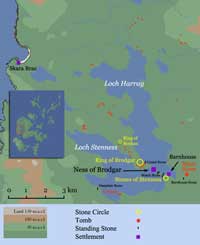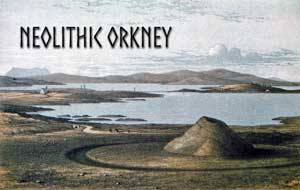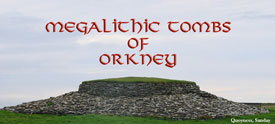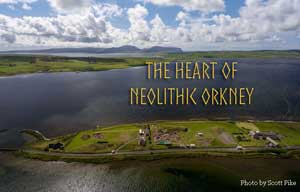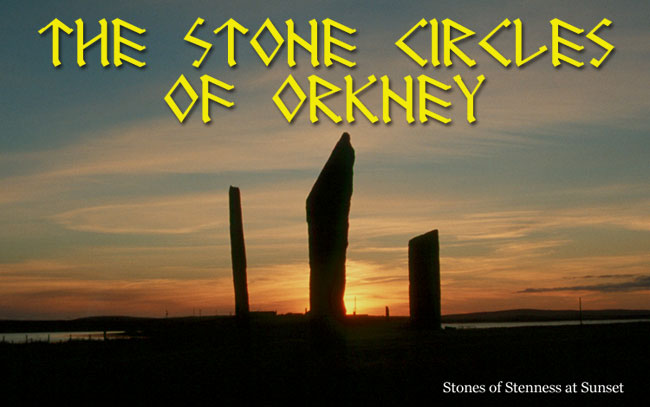
Introduction
Although henge monuments can be found elsewhere in Scotland, at Cairnpapple Hill just outside Edinburgh and Balfarg in Fife for example, they can hardly be considered common. It is a little bit surprising, therefore, that there are two major henge monuments within a mile of one another in the remote Orkney Islands.
The islands of Orkney lie off the extreme northeast corner of the Scottish mainland and, although the distance is only a few miles, the intervening stretch of water—the Pentland Firth—is among the most treacherous in the world. Violent tidal races flow through from the North Sea and the Atlantic and gale force winds are not infrequent. Even so, they were settled very early in the Neolithic. The 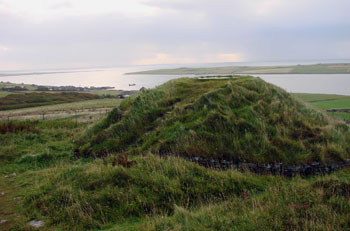 houses at Knap of Howar on Papa Westray, which date to about 3600 BC, represent the earliest standing buildings in Europe. As was the case elsewhere in Europe, the inhabitants erected chambered tombs to serve as repositories for the bones of their ancestors and to mark their territory. Over 80 have been discovered so far in the islands, which fall into two basic types— smaller, simpler family tombs known as Orkney-Cromarty Cairns (by far the more numerous) and the larger and more complex Maes Howe type. Left is the tomb of Taversoe Tuick on the island of Rousay.
houses at Knap of Howar on Papa Westray, which date to about 3600 BC, represent the earliest standing buildings in Europe. As was the case elsewhere in Europe, the inhabitants erected chambered tombs to serve as repositories for the bones of their ancestors and to mark their territory. Over 80 have been discovered so far in the islands, which fall into two basic types— smaller, simpler family tombs known as Orkney-Cromarty Cairns (by far the more numerous) and the larger and more complex Maes Howe type. Left is the tomb of Taversoe Tuick on the island of Rousay.
Of all the tombs, by far the most impressive is Maes Howe itself. It looks onto a pair of lochs, the Lochs of Harray and of Stenness, separated by a narrow spit of land. It is interesting, therefore, that there are two great stone circles here—the Stones of Stenness and the Ring of Brodgar. In addition to the circles and the tomb, there are a number associated sites, including a henge monument at Bookan, a number of Bronze Age tombs and several standing stones. So dense is the concentration that the area has been designated a World Heritage Site, the Heart of Neolithic Orkney.
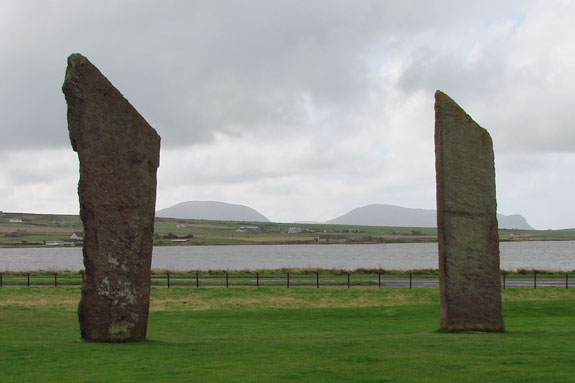
Looking southwest, towards the hills of Hoy, from the Stones of Stenness
Within 100 metres or so of Stenness (and probably contemporary with it) is small village known as Barnhouse. The unusual character of the buildings (discussed in greater detail in an upcoming article) suggests that they may have housed a community of priests or priestesses.
It has been suggested that the smaller of the two circles, the Stones of Stenness, is the earlier. Both are associated with tombs but, while those near Stenness are mainly Neolithic in date, the Ring of Brodgar is surrounded by round cairns belonging to the Early Bronze Age.
Since 2003, there have been annual excavations at Ness of Brodgar, the area just north of the causeway separating the two stone circles. These are bound to have an enormous impact on our understanding of the relationships among all of the monuments in the vicinity. The results of these will be outlined in a forthcoming series of articles. The first is available now and is called The Heart of Neolithic Orkney.
Further Reading
| Burl, Aubrey | (1993) | From Carnac to Callanish |
| (2000) | Stone Circles of Britain, Ireland and Brittany | |
| Cunliffe, Barry | (2001) | Facing the Ocean: The Atlantic and its Peoples |
| Garnham, Trevor | (2004) | Lines on the Landscape, Circles from the Sky |
| Renfrew, Colin | (1979) | Investigations in Orkney, Society of Antiquaries of London, Research Report No. 38 |
| Renfrew, Colin (edit.) | (1985) | The Prehistory of Orkney |
| Richards, Colin (edit.) | (2005) | Dwelling among the monuments |
| (2013) | Building the Great Stone Circles of the North | |
| Ritchie, Anna | (1996) | Orkney |
| Ritchie, J.N.G. | (1978) | ‘The Stones of Orkney,’ Proc. Soc. Antiq. Scot., 107 |
| Scarre, Chris | (2007) | The Megalithic Monuments of Britain and Ireland |
| Thom, Alexander | (1970) | Megalithic Lunar Observatories |
| Wickham-Jones, Caroline | (2006) | Between the Wind and the Water, World Heritage Orkney |

